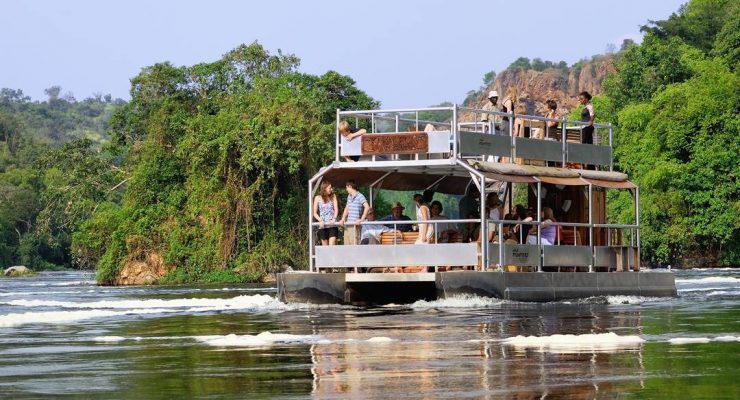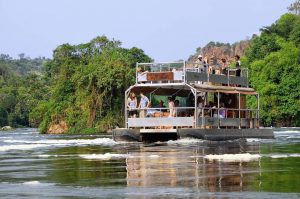Queen Elizabeth National Park (QENP) is Uganda‘s most visited national park and the best-known, most popular destination.

Unequalled for its natural beauty and diverse ecosystem such as sprawling savanna, crater Lakes, and fertile wetlands, it has the greatest concentration of plains game, primate species and over 600 bird species in Uganda
The park was established in 1952 as Kazinga Channel and renamed two years after to commemorate a visit by Queen Elizabeth II.
The resident population of tree –climbing lions, elephants, buffalos, and birds is also impressive. There’s a wide variety of accommodation available, from luxury lodges to budget camps. The park covers 1,978km2

Things to Do
Boat Cruise- Kazinga Channel – Queen Elizabeth National Park
The boat-cruise on Kazinga Channel offers an excellent platform for photography and game viewing in Queen Elizabeth National Park.
Balloon safaris
Balloon safaris in Queen Elizabeth National Park is a romantic and evocative way of experiencing the wilderness of Uganda, as you gracefully and silently fly over the savannah teeming with herds of wild life in the early morning.
Usually, a balloon safari begins between 6 am and lasts for around 1-2 hours, during which you will likely see the magnificent wildlife below over several square kilometres of the game park. The safari is followed by a champagne breakfast in the bush, a fitting end to your memorable flight in the wild.
Birding safaris
Queen Elizabeth National Park is paradise for birders. Classified as an Important Birding Area (IBA) by Birding International, Queen’s great variety of habitats mean it is home to over 600 species. The birdlife is colourful and abundant.
Wildlife Safaris & Game
Queen Elizabeth National Park’s diverse eco-system of grassy plains, tropical forest, rivers, swamps, lakes and volcanic craters hence making it a paradise for game viewing. The Park is a home to lion, leopard, and giant forest hog, Cape buffalo, elephants, De fassa waterbuck, Uganda Kob, Topi and bush buck.
Chimpanzee Trekking
You can trek chimpanzees from Kyambura Gorge or Kalinzu Forest accessible from Mweya of Queen Elizabeth National Park. Both Kyambura Gorge and Kalinzu Forest are in close proximity of Queen Elizabeth National Park.
Nature Walks
Accompanied by a trained and experienced field guide, Mweya Peninsula offers savannah and woodland with beautiful views of Queen Elizabeth National park.
Guides will expertly teach you how to recognise and follow various wildlife tracks.
At the southern end of the park, visitors can enjoy an easy stroll along the Ishasha River, where they can spot a variety of forest and savanna bird and mammal species as well as having a unique opportunity on this walk to get extremely close to hippos on foot, while remaining perfectly safe on the raised bank above the river.
Cultural Tours
With local guides born and raised in and around Queen Elizabeth National Park, you can discover how many steps it takes to harvest salt at Katwe Salt Lake, pick, dry, roast, pound and brew fresh aromatic coffee.
Participate in cultural dances by Kikorongo Equator Cultural dancers and as well as exploring Uganda’s unforgotten traditions and a way of life that is closely linked to nature and wildlife around Queen Elizabeth National Park.
Accommodations
There is a varied choice of accommodation for fly in safaris and tours in Queen Elizabeth national park, depending on your taste.
From eco-lodges, tented camps, reflect the different Ugandan safari vacation experience you are seeking from total comfort.
Some of the luxury lodges in Queen Elizabeth National Park includes, Mweya Safari Lodge, Park View Safari Lodge, Kyambura Game Lodge, Hippo Safari Lodge, Ishasha Wilderness Camp, Jacana Safari Lodge, Enganzi Game Lodge.
Best Time to Visit the Park
All Year around, the dry season (from late June to August) and (December to February offers the best primate and wildlife viewing in general.
Best Weather – June- July and January to February
Rainy Season – March, April and May


